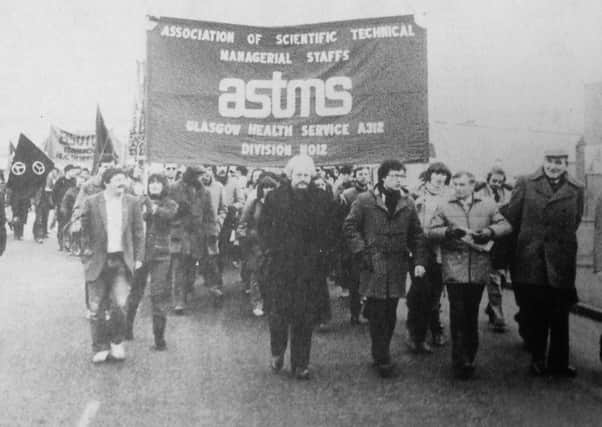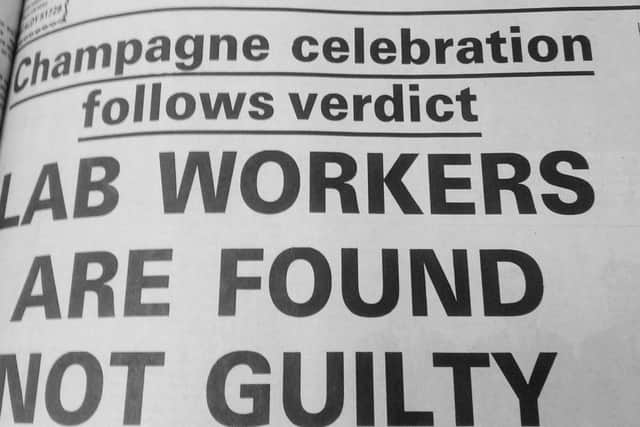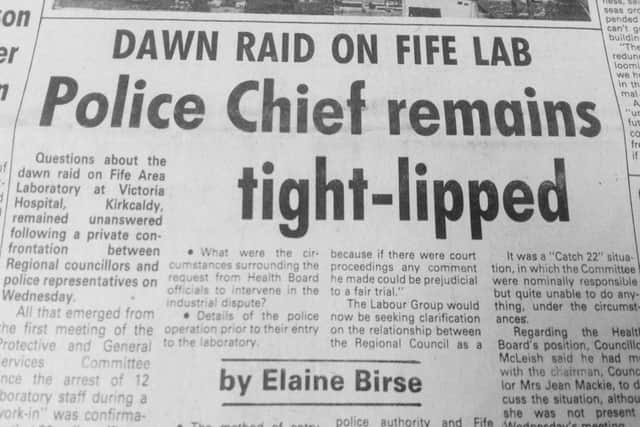Police dawn raid that put Fife lab workers in court under 100-year old law


But one of the most shocking and controversial actually involved laboratory staff at Victoria Hospital.
A long-running dispute with health bosses led to a work-in which saw police stage a dawn raid and arrest 12 people under a 108-year old law.
Advertisement
Hide AdAdvertisement
Hide AdThat, in turn, led to a criminal prosecution which ended up at the highest court in the land – even the Secretary of State for Scotland got involved.


The story centred around medical laboratory specialist officers (MLSOs) being told they could not sign reports without a consultant seeing them first.
This long-running, internal dispute exploded in 1982.
By October of that year, threats of an all-out UK-wide strike by lab staff who were members of the Association of Scientific, Technical and Managerial Staff (ASTMS) had just been averted, but that was just the beginning.
A ceasefire agreed with Fife Health Board was shattered when a staff member was suspended for refusing to follow the directive on medical notes.


A “sudden and dramatic” escalation of events then followed.
You might also be interested in:
Advertisement
Hide AdAdvertisement
Hide AdA dozen lab workers staged a work-in in protest, locking themselves in the labs.
It lasted barely 12 hours, but the manner in which it was broken up sparked an astonishing sequence of events.
The protest was ended with a full-scale dawn raid as police, called in by senior executive members of the health board, broke through the barricaded doors, and arrested 12 members of staff – five men and seven women.
The sheer scale of the operation – it involved some 30 officers and was led by senior figures such as Chief Superintendent Dick Borrar – sparked such outrage that George Younger, Secretary of State for Scotland demanded a report on his desk from Robert Murison, Fife’s Chief Constable. Councillors also summoned the police chief to a meeting.
Advertisement
Hide AdAdvertisement
Hide AdThe morning of the raid saw the health board granted an interim interdict at the Court of Session which prevented the “Victoria 12” from entering the labs or interfering with its work.
As politicians piled into the row, the Chief Constable refused to answer 21 of 22 questions put to him in a private meeting with councillors, prompting union leaders to threaten to put him in the witness box if the case went to trial.
And it did.
December 1982 saw 11 of the Victoria 12 – the other was ill – cram into the dock at Kirkcaldy Sheriff Court to be charged under Section 7 of the Conspiracy and Protection of Property Act of 1875 which stated that they “watched and beset” the Fife area laboratory.
The use of a century old law fuelled a real sense of anger.
Advertisement
Hide AdAdvertisement
Hide AdCourt One was packed, while a silent protest was staged outside as the five-day trial got under way in February 1983. Almost 300 union members from across Scotland staged the demo in the Town Square, while lab staff at the Vic stopped working in solidarity.
By day three, charges against three female workers were dropped and they walked free.
That left eight others in the dock – charges against a 12th man were dropped on health grounds.
Giving evidence, the Chief Constable said he only sent officers to the labs to see if any crime had been committed. Staff argued a work-in was well within trade union legislation, while health board bosses insisted staff had been denied access to the labs, endangering patients.
Advertisement
Hide AdAdvertisement
Hide AdMr Murison’s evidence suggested the workers were prepared, having come with bedding and clothing.
They were originally charged under the Trespass (Scotland) Act of 1865. Incredibly, the female workers taken into custody were stripped of their bras and tights ... to prevent attempted suicide.
In March, Sheriff William Christie issued his verdict. Not guilty.
He ruled the remaining eight acted within the Trade Union and Labour Relations Act of 1974 The champagne flowed in a nearby hotel, while Clive Jenkins sent a special message, hailing “an impressive legal victory”.
But the case wasn’t over.
Advertisement
Hide AdAdvertisement
Hide AdThe Crown appealed, and George Younger stepped in with a new directive on how staff should operate in two departments in Fife labs. It was applied with immediate effect, leaving unions appalled and ASTMS adopting a policy of non-co-operation.
A date in June was set for the appeal. Three of Scotland’s top judges ruled Sheriff Christie was wrong to halt the trial, but said the acquittals would stand.
Lord Mackay, Lord Advocate for the Crown, said the workers’ actions went further than an industrial dispute. In effect, the Crown won its appeal, but immediately said it would drop all charges.
That turned the spotlight back on the actions of the police in staging the dawn raid.
Advertisement
Hide AdAdvertisement
Hide AdLord Cameron expressed “regret and some surprise” at the police action, noting: “It does not appear to me that the interests of justice would have been prejudiced had sufficient time been allowed to permit consultation with the criminal authorities before decisive and forceful action was taken by police after they were called in by medical officers.”